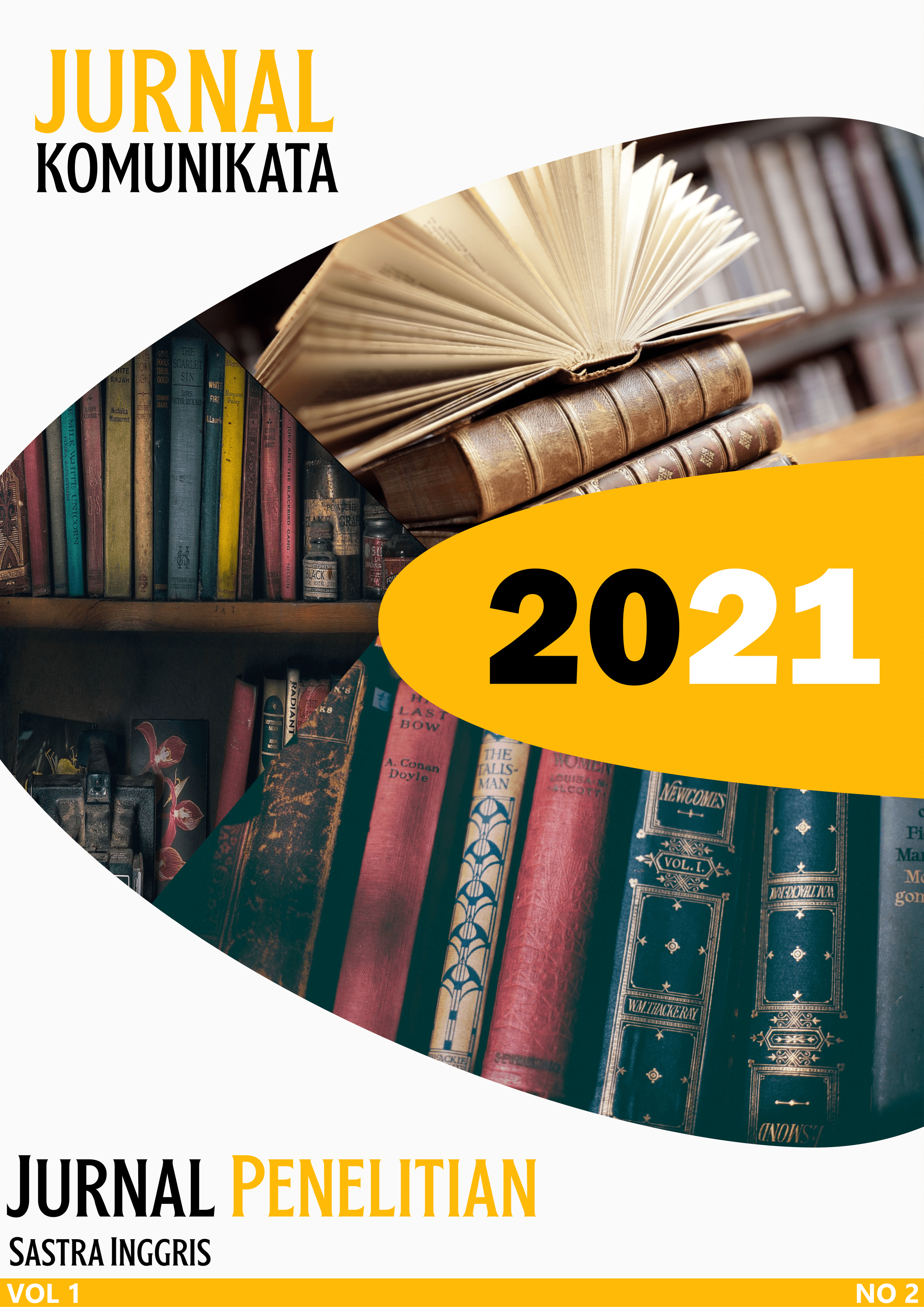AN ANALYSIS OF SPEECH ACT USED BY THE CHARACTERS IN HARRY POTTER AND THE CHAMBER OF SECRET MOVIE TRANSCRIPT
Kata Kunci:
Movie Transcript, Speech ActAbstrak
This research is compiled to answer two problem formulations, what are the meanings could be figured out and the speech act classifications from the utterances uttered by the characters in Harry Potter and the Chamber of Secret movie transcript, which represent our daily activities in communications. Those five classifications are included in declarative, representative, expressive, directives and commissives. To analyze this research, the writer imposes some theories related to speech acts from some experts such as Searle, Yule and others and some experts’ ideas to help the analysis. This research also uses descriptive qualitative which means the data are collected and analyzed in the form of written. The achievements of this research are, firstly, the meaning that seen contextually, the writer found that most of the speaker utters the utterances causes by the situation or condition. Secondly, in speech act classifications the speakers the writer could find five speech act classification. Most of the speaker speaks based on needed, like the headmaster and teacher that declare, or another characters that represent their believes, express their feeling, ask their wants, and intends their promises.
Referensi
Abidin, Z., Permata, P., & Ariyani, F. (2021). Translation of the Lampung Language Text Dialect of Nyo into the Indonesian Language with DMT and SMT Approach. INTENSIF: Jurnal Ilmiah Penelitian Dan Penerapan Teknologi Sistem Informasi, 5(1), 58–71.
Aminatun, D., & Oktaviani, L. (2019). Memrise: Promoting students’ autonomous learning skill through language learning application. Metathesis: Journal of English Language, Literature, and Teaching, 3(2), 214–223.
Azijah, D. P. (2020). INTERPERSONAL METADISCOURSE MARKERS IN JACINDA ARDERN’S SPEECH AT CHRISTCHURCH MEMORIAL. Universitas Teknokrat Indonesia.
Dosia, P. A., & Rido, A. (2017). Production of English diphthongs: A speech study. Teknosastik, 15(1), 21–35.
Gulö, I. (n.d.). IMPLEMENTATION OF ENGLISH THEME AND RHEME TO NIAS LANGUAGE.
Gulö, I. (2014). Unique characteristics of Nias language. International Journal of English and Education, 3(3), 26–32.
Isnain, A. R., Sihabuddin, A., & Suyanto, Y. (2020). Bidirectional Long Short Term Memory Method and Word2vec Extraction Approach for Hate Speech Detection. IJCCS (Indonesian Journal of Computing and Cybernetics Systems), 14(2), 169–178.
Ivana, P. S. I., & Suprayogi, S. (2020). THE REPRESENTATION OF IRAN AND UNITED STATES IN DONALD TRUMP’S SPEECH: A CRITICAL DISCOURSE ANALYSIS. Linguistics and Literature Journal, 1(2), 40–45.
Karal, H., Kokoc, M., & Cakir, O. (2017). Impact of the educational use of Facebook group on the high school students’ proper usage of language. Education and Information Technologies, 22(2), 677–695.
Kuswoyo, H. (n.d.). Advances in Language and Literary Studies Declarative Sentence Pattern In" Laskar Pelangi" And" The Rainbow Troo...
Mandasari, B. (n.d.). FACTORS INFLUENCING TEACHERS’BELIEFS ON THE USE OF AUTHENTIC MATERIALS TO TEACH LISTENING.
Mandasari, B., & Agusty, S. T. P. (n.d.). MOBILE LEARNING: THE IMPACT OF WHATSAPP USAGE IN ENGLISH LANGUAGE LEARNING. Section Editors.
Mulyasari, F., & Putri, S. N. (2020). THE IMPACT OF WHATSAPP GROUP ON UNDERGRADUATE STUDENTS‟ WRITING IN THE INDONESIAN TERTIARY CONTEXT. PROCEEDINGS UNIVERSITAS PAMULANG, 1(1).
Nazara, W. (2019). A note on the form and use of the language of Nias. Teknosastik, 17(1), 15–22.
Oktavia, W. R., & Suprayogi, S. (2021). GRAMMATICAL COHESION IN BORIS JOHNSON’S SPEECH ENTITLED CORONAVIRUS SPREAD IN UK. Linguistics and Literature Journal, 2(1), 8–16.
Puspita, D. (2021). TED-Talk: A Listening Supplemental Material for Learning English. The 1st International Conference on Language Linguistic Literature and Education (ICLLLE).
Pustika, R. (n.d.). ARISING BILINGUAL CHILDREN BY PROMOTING SECOND LANGUAGE AWARENESS.
Qodriani, Laila U, & Wijana, I. D. P. (2020). “Drop your ‘Hello!’here!”: Investigating the Language Variation Used in Online Classroom for Tertiary Level in Indonesia. International Joint Conference on Arts and Humanities (IJCAH 2020), 617–623.
Qodriani, Laila Ulsi. (n.d.). The Use of Phatic Particle ‘Geh’in Lampungnese’s Indonesian Language.
Qodriani, Laila Ulsi, & Wijana, I. D. P. (2020). Language Change in ‘New-Normal’Classroom. 4th International Conference on Language, Literature, Culture, and Education (ICOLLITE 2020), 385–389.
Rido, A. (2020). Interaction & Pedagogy of Indonesian Vocational English Language Master Teachers. Penerbit Universiti Kebangsaan Malaysia.
Rido, A., & Sari, F. M. (2018). Characteristics of classroom interaction of English language teachers in Indonesia and Malaysia. International Journal of Language Education, 2(1), 40–50.
Rido, A., Sari, F. M., Suri, R. A. M., & Duantoro, H. (2017). Discourse Structure of Lecture in L2 in the Indonesian Tertiary Context. Proceedings of ISELT FBS Universitas Negeri Padang, 5, 11–20.
Sari, F. M. (2018). EFL STUDENTS’DILEMMA: FACTORS DETERMINING THEIR TALK IN THE LANGUAGE LEARNING PROCESS. Kolita.
Sari, F. M. (2020). Exploring English Learners’ Engagement and Their Roles in the Online Language Course. Journal of English Language Teaching and Linguistics, 5(3), 349–361.
Sari, F. M., Sukirlan, M., & Suka, R. G. (2013). IMPROVING STUDENTS’LISTENING ABILITY THROUGH DICTATION TECHNIQUE AT THE FIRST YEAR STUDENTS. U-JET, 2(3).
Sari, F. M., & Wahyudin, A. Y. (2019). Blended-Learning: The responses from non-English students in the Indonesian tertiary context. Teknosastik, 17(1), 23–28.
Schrape, J.-F. (2018). Social Media, Mass Media and the “Public Sphere”. Differentiation, Complementarity and Co-Existence. SSRN Electronic Journal. https://doi.org/10.2139/ssrn.2858891
Suprayogi, S. (2021). PRELIMINARY STUDY ON MAPPING CURRENT DOCUMENTATION AND REVITALIZATION MEASURES FOR LAMPUNGIC LANGUAGE. The 1st International Conference on Language Linguistic Literature and Education (ICLLLE).
Tanenhaus, M. K., Magnuson, J. S., Dahan, D., & Chambers, C. (2000). Eye movements and lexical access in spoken-language comprehension: Evaluating a linking hypothesis between fixations and linguistic processing. Journal of Psycholinguistic Research, 29(6), 557–580.
Wahyudin, A. Y. (2015). The implementation of scientific method in teaching English as a foreign language at senior high school level. Universitas Pendidikan Indonesia.


